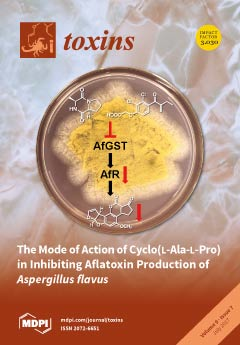There are a total of 30 strains including 27 strains of
Aspergillus niger intended used in Chinese food industry, two strains used as control and one strain isolated from corn for fumonisin (FB) production on 3 media. It was found that FB
2 production by
A. niger was function-dependent and highly related to culture media, as well as incubation time. All strains studied were unable to produce FB
1 and FB
3. Almost all strains were found to produce FB
2 on corn, rice and wheat bran. Based on their intended use in the food industry, the higher level of FB
2 producers were strains used for saccharifying enzyme (
n = 13) production, followed by organic acid (
n = 6), tannase (
n = 7) and β-galactosidase (
n = 1) production, with the FB
2 mean level of 3553–10,270 μg/kg, 1059–12,036 μg/kg, 3–7 μg/kg and 2–4 μg/kg on corn, 5455–9241 μg/kg, 559–2190 μg/kg, 4–9 μg/kg and 6–10 μg/kg on rice, 5959–7709 μg/kg, 9491–17,339 μg/kg, 8–14 μg/kg and 120–222 μg/kg on wheat bran, respectively. Comparatively, strains of
Fusarium verticillioide were capable of producing fumonins simultaneously with broader spectrum including FB
1, FB
2 and FB
3, but at a much lower level. In conclusion, it is necessary to evaluate FB
2 production by
A. niger before intended use in the food processing industry.
Full article






